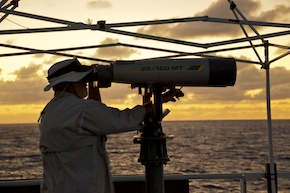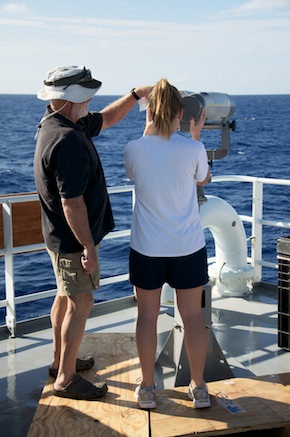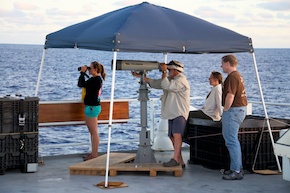The R/V Thomas G. Thompson left Honolulu on November 5, 2011 heading toward the Western Pacific. This expedition journal was written by cruise participants and uploaded about once per weekday, depending on internet availability.
November 15, 2011: Our Protected Species Observers (PSOs)

Gary on the morning shift (Credit: Will Koeppen)
Being a marine science major with a concentration in biology, I wanted to get to know more about what the protected species observers on our cruise do. On this cruise, we have three observers: Gary Friedrichsen, Bridget Watts, and Julia O’Hern. They are here because of the Marine Mammal Protection Act, which prohibits activities that harass marine mammals and other creatures such as sea turtles. The seismic surveys during this cruise are considered to be activities that might disturb protected species in the area. Because of those activities we had to apply for and receive a US government permit for this research.

Using the big eyes (Credit: Will Koeppen)
This morning we did our first deployment of seismic gear. The seismic survey on this cruise is using two air guns to produce a low frequency signal that may cause harm to the animals near the boat. As such, the protected species observers had to be up early to look out for any marine life in the area before the air guns could be turned on. After observing for 30 minutes without seeing anything, the observers gave the OK and the air guns could begin operation. While the seismic survey went on, the observers used both of their 25X powered binoculars, which they call "big eyes", to monitor an area around the boat. This area includes 670 meters distance from the bow and sides of the ship. If a mammal or sea turtle comes within 70 meters, the air guns must be shut down. However, outside of this range our permit allows the survey to continue while the observers closely monitor the animals in case they head towards the boat (perhaps even out of curiosity).
The observers use a calculated chart and binoculars to determine the distance between the boat and the marine organism. The binoculars have reticle scales, like a microscope, and the observers first line up the top reticle with the horizon and count downwards to where the mammal or sea turtle is. They take that number of reticles and compare it to their cheat sheet that has the already calculated distances per reticle. Although this is a fairly accurate way of detecting the distance, there are still some sources of error such as the sea state, weather forecast, and the glare from the sun.
There are no special requirements to become a protected species observer in the US, but if they want to work overseas some regions require certification, which they must pay for themselves. Gary has been working as an observer for 41 years, and he does other work with population studies of marine life as well. For 11 years, Bridget has been working as an observer, while Julia has been one for 4 years. All three like doing this kind of work not only because it pays the bills, but also because they like the people they work with and they have fun doing their job.

Our PSOs and Carl, whalespotting
(Credit: Will Koeppen)
Yesterday, while we were in transit, we had our first whale sighting. It was sighted in the morning by naked eye, and Julia came to the conclusion that it was a large Baleen whale that was about 1.5 miles away. Another sighting happened during dinner, when Gary had determined that there was a pod of Bryde’s Omura that were about two miles away from the boat. We could see their spouts without binoculars, but using the big eyes was also very cool because we could see dorsal fins and other details that helped identify the whales. Hopefully we get to see more marine life as the cruise continues on, but only on days when we’re not doing seismic surveys! ♦
